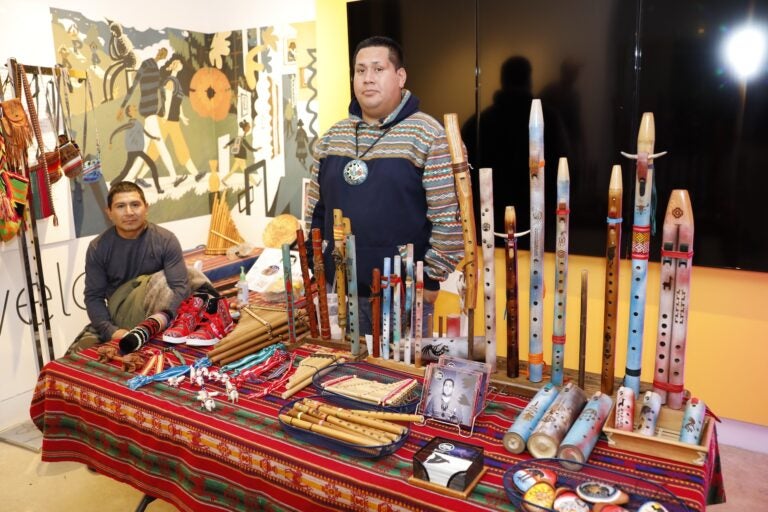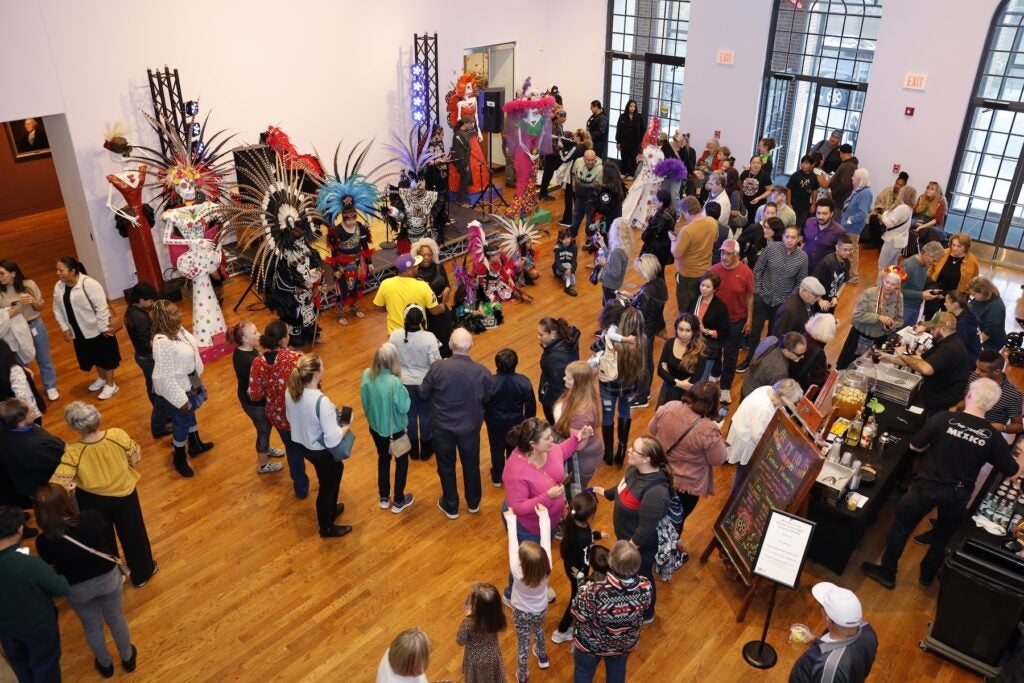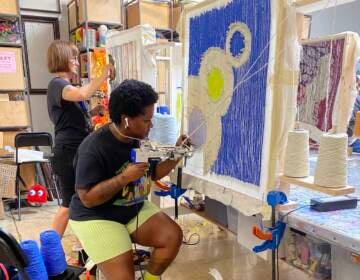Delaware Art Museum celebrates life and heritage during 6th annual Dia de los Muertos
The Delaware Art Museum brought together art, music and tradition to honor ancestors and celebrate Latin American culture for Día de los Muertos.
Listen 1:19
Peruvian artist Richi Olivera joined the Delaware Art Museum’s sixth annual Día de los Muertos celebration, showcasing and selling his handcrafted flutes made from wood and bamboo. (Courtesy of Hoy en Delaware)
What are journalists missing from the state of Delaware? What would you most like WHYY News to cover? Let us know.
Inside the Delaware Art Museum, two altars became the focal point of the event – filled with marigolds, photos of passed loved ones, candles, pumpkins and corn. The sixth annual Dia de los Muertos celebration began with a cultural ceremony in front of the ofrenda stand or altar, where community members gathered to honor loved ones and celebrate the living traditions that keep their memories alive.
The event, hosted as part of the museum’s DelArt Nights series, featured local artists, live performances, food and vendors who shared pieces of their heritage through art and music.
For Delaware Art Museum’s community engagement specialist Iz Balleto, the evening was about more than just celebration — it’s about unity and remembrance.
“Es de ver toda la gente que están aquí presente, lo todo que soportan, porque esto es con ánimo de amor para la gente que entienden de otra cultura”, dijo Balleto. “Yo también como peruano, para entender como día de los muertos significa tanto a la gente de México, pero a otras naciones indíginamente. La cosa es de aprender, de aprender de uno y de nuestros ancestros, porque es importante que nunca nos olvidemos quién vino antes de nosotros”.
“It’s inspiring to see all the people here, all they endure, because this is done with love for people who understand other cultures,” Balleto said. “As a Peruvian, I also understand how much the Day of the Dead means to people from Mexico, but also to other indigenous nations. The point is to learn, to learn from ourselves and from our ancestors, because it’s important that we never forget who came before us.”
The motive behind creating the event was to take a proactive approach to end racism and educate others about different cultures through the arts, with the intention to build connection and change.
“Yo quería combatir el racismo contra la gente que no quería saber de la otra gente”, él dijo. said. “Yo lo hice esto a propósito para que la gente aprende, aprende de la cultura, aprende de la gente y así el arte y la cultura siempre puede combatir especialmente el racismo”.
“I wanted to combat racism against people who didn’t want to know about other people,” he said. “I did this on purpose so that people learn, learn about culture, learn about the people, and so art and culture can always combat racism, especially.”

As the night continued, visitors explored a marketplace filled with crafts, art and sounds that carried across the museum’s halls –– including handmade bamboo flutes created by Peruvian artisan and musician Richie Olivera.
“Estas flautas son mis creaciones, están hechas de bambú y madera”, dijo Olivera desde detrás de su mesa de vendedor. “Todas son mayormente flautas nativas americanas y también tengo flautas de Sudamérica y lo que trato de mostrar al público prácticamente es parte de mi cultura y también que la gente se eduque en tratar de tocar esas flautas”.
“These flutes are my creations; they’re made of bamboo and wood,” Olivera said from behind his vendor table. “They’re mostly Native American flutes, and I also have flutes from South America. What I’m trying to show the public is essentially part of my culture, and also to educate people by teaching them how to play these flutes.”
Originally from Peru, Olivera said he’s lived in the United States for about two decades — and for him, being part of cultural events like this one is deeply meaningful.
“Me siento muy contento porque eh yo sé que es difícil estando en un país que no es de nosotros, un país ajeno”, él dijo. “Pues este me gusta también juntarme con mi gente y me gusta compartir también y compartir las tradiciones y la cultura también”.
“I feel very happy because I know it’s difficult being in a country that isn’t ours, a foreign country,” he said. “I also like to get together with my people and I like to share and share our traditions and culture as well.”
Balleto says moments like these capture the true purpose of Día de los Muertos — connection through shared learning, pride and love.
“Yo quiero que ellos aprendan que tengan orgullo, orgullo de ser indígena, orgullo de ser de raza, orgullo de ser de nuestra parte de la gente de la tierra”, Bellato dijo. “Para el próximo año el que quiere estar presente y aprender más, ven con orgullo y vas a salir con amor”.
“I want them to learn, to have pride… pride in being Indigenous, pride in their heritage, pride in being part of our community,” Bellato said. “Next year, whoever wants to be here and learn more, come with pride, and you will leave with love.”


Get daily updates from WHYY News!
WHYY is your source for fact-based, in-depth journalism and information. As a nonprofit organization, we rely on financial support from readers like you. Please give today.







